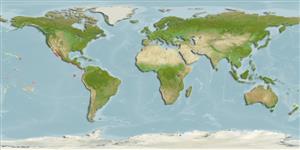Preferred temperature (Ref.
123201): 22.5 - 29.1, mean 27.1 °C (based on 214 cells).
Phylogenetic diversity index (Ref.
82804): PD
50 = 0.5005 [Uniqueness, from 0.5 = low to 2.0 = high].
Bayesian length-weight: a=0.00562 (0.00258 - 0.01228), b=3.06 (2.87 - 3.25), in cm total length, based on LWR estimates for this (Sub)family-body shape (Ref.
93245).
ຊັ້ນເຂດຮ້ອນ (Ref.
69278): 4.4 ±0.78 se; based on food items.
ຄວາມຢືດຢຸ່ນ (Ref.
120179): ສູງ, ປະຊາກອນຕຳ່ສຸດທີ່ໃຊ້ເວລາສອງໜ້ອຍກວ່າ 15 ເດືອນ (Preliminary K or Fecundity.).
Fishing Vulnerability (Ref.
59153): Low vulnerability (10 of 100).
Nutrients (Ref.
124155): Calcium = 128 [65, 229] mg/100g; Iron = 0.812 [0.458, 1.384] mg/100g; Protein = 18.6 [17.5, 19.7] %; Omega3 = 0.112 [0.060, 0.208] g/100g; Selenium = 21.2 [10.0, 49.6] μg/100g; VitaminA = 264 [93, 733] μg/100g; Zinc = 1.46 [0.93, 2.17] mg/100g (wet weight);
